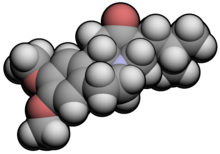Xenazine
 |
|
 |
|
| Clinical data | |
|---|---|
| Trade names | Xenazine, Nitoman |
| AHFS/Drugs.com | Consumer Drug Information |
| Pregnancy category |
|
| Routes of administration |
Oral (tablets) |
| ATC code | |
| Legal status | |
| Legal status | |
| Pharmacokinetic data | |
| Bioavailability | Low, extensive first pass effect |
| Protein binding | 82–85% |
| Metabolism | Hepatic (CYP2D6-mediated) |
| Excretion | Renal (~75%) and fecal (7–16%) |
| Identifiers | |
|
|
| Synonyms | Ro-1-9569 |
| CAS Number | |
| PubChem CID | |
| IUPHAR/BPS | |
| DrugBank | |
| ChemSpider | |
| UNII | |
| KEGG | |
| ChEMBL | |
| ECHA InfoCard | 100.000.348 |
| Chemical and physical data | |
| Formula | C19H27NO3 |
| Molar mass | 317.427 g/mol |
| 3D model (JSmol) | |
| Chirality | Racemic mixture |
|
|
|
|
Tetrabenazine is a drug for the symptomatic treatment of hyperkinetic movement disorders. It is marketed under the trade names Nitoman in Canada and Xenazine in New Zealand, some parts of Europe and in the United States as an orphan drug. On August 15, 2008, the U.S. Food and Drug Administration approved the use of tetrabenazine to treat chorea associated with Huntington's disease. Although other drugs had been used "off label," tetrabenazine was the first approved treatment for Huntington's disease in the U.S. The compound has been known since the 1950s.
Tetrabenazine is used as a treatment, but not as a cure, for hyperkinetic disorders such as:
The most common adverse reactions, which have occurred in at least 10% of subjects in studies and at least 5% greater than in subjects who received placebo, have been: sedation or somnolence, fatigue, insomnia, depression, suicidal thoughts, akathisia, anxiety and nausea.
There is a boxed warning associated with the use of tetrabenazine:
The precise mechanism of action of tetrabenazine is unknown. Its anti-chorea effect is believed to be due to a reversible depletion of monoamines such as dopamine, serotonin, norepinephrine, and histamine from nerve terminals. Tetrabenazine reversibly inhibits vesicular monoamine transporter 2, resulting in decreased uptake of monamines into synaptic vesicles, as well as depletion of monoamine storage.
...
Wikipedia
